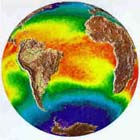Ozone hole recovery may reshape southern hemisphere climate change
 Washington, April 25 : A new study has determined that recovering the Antarctic ozone hole may help in modifying climate change in the southern hemisphere and even amplify Antarctic warming.
Washington, April 25 : A new study has determined that recovering the Antarctic ozone hole may help in modifying climate change in the southern hemisphere and even amplify Antarctic warming.
Scientists from the University of Colorado at Boulder, the National Oceanic and Atmospheric Administration and NASA conducted the study.
While Earth’s average surface temperatures have been increasing, the interior of Antarctica has exhibited a unique cooling trend during the austral summer and fall caused by ozone depletion.
“If the successful control of ozone-depleting substances allows for a full recovery of the ozone hole over Antarctica, we may finally see the interior of Antarctica begin to warm with the rest of the world,” said Judith Perlwitz of the Cooperative Institute for Research in Environmental Sciences.
For the study, the authors used a NASA supercomputer model that included interactions between the climate and stratospheric ozone chemistry to examine how changes in the ozone hole influence climate and weather near Earth’s surface.
The study authors calculated that when stratospheric ozone levels return to near pre-1969 levels by the end of the 21st century, large-scale atmospheric circulation patterns now shielding the Antarctic interior from warmer air masses to the north will begin to break down during the austral summer.
The scientists found that as ozone levels recover, the lower stratosphere over the polar region will absorb more harmful ultraviolet radiation from the sun.
This could cause air temperatures roughly 6 to 12 miles above Earth's surface to rise by as much as 16 degrees fahrenheit, reducing the strong north-south temperature gradient that currently favors the positive phase of SAM (Southern Annular Mode), said the research team.
The supercomputer modeling effort also indicated that ozone hole recovery would weaken the intense westerly winds that currently whip around Antarctica and block air masses from crossing into the continent’s interior.
As a result, Antarctica would no longer be isolated from the warming patterns affecting the rest of the world.
According to Steven Pawson from NASA, ozone recovery over Antarctica would essentially reverse summertime climate and atmospheric circulation changes that have been caused by the presence of the ozone hole.
“It appears that ozone-induced climate change occurred quickly, over 20 to 30 years, in response to the rapid onset of the ozone hole,” he said.
“These seasonal changes will decay more slowly than they built up, since it takes longer to cleanse the stratosphere of ozone-depleting gases than it took for them to build up,” he added. (ANI)